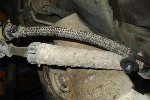Re slightly different size diameters on rear axle: That shouldn't cause any harm -- to the transfer case or anything else.
The wheel with the smaller tire will rotate a bit faster than the larger one. But wheels rotate at different speeds all the time -- in a turn, the outside tire has to rotate faster than the inside tire because it's covering a longer distance. That's why God invented the differential.
Note that "space saver" spare tires are considerably smaller than the full-sized ones, and can be safely used on either front or rear axles. Many years ago, a guy drove the "One Lap of America" race using a space saver on one wheel, just to show it could be done.
I also agree re plug and patch, but definitely put the repaired tire on a rear wheel. In the (unlikely) event that the repair fails, you'll still have full steering control. Also, different sized tires on the front wouldn't cause differential problems, but could affect steering/handling somewhat.










